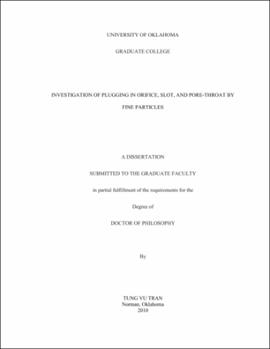| dc.contributor.advisor | CIVAN, FARUK | |
| dc.creator | Tran, Tung Vu | |
| dc.date.accessioned | 2019-04-27T21:26:13Z | |
| dc.date.available | 2019-04-27T21:26:13Z | |
| dc.date.issued | 2010 | |
| dc.identifier | 99190159502042 | |
| dc.identifier.uri | https://hdl.handle.net/11244/318683 | |
| dc.description.abstract | orifice- or slot-to-particle-size ratio on flowing fluid conditions and plugging time that lead to particle bridging. It was demonstrated that the critical orifice- or slot-to-particle-size ratio vs. particle-volume-fraction Reynolds number could be correlated satisfactorily using an exponential function and the dimensionless plugging time vs. reciprocal-particle-volume-fraction yields a power-law-type correlation. Such empirical correlations can be used to determine and avoid the conditions which induce perforation, fracture, slot and pore plugging by migrating particles in petroleum reservoirs. The dimensionless correlations developed here can also be used as a screening tool to choose the best lost circulation material (LCM) candidates. | |
| dc.description.abstract | Second, the measured permeability reduction obtained from laboratory tests by injecting particulate drilling fluid in a representative core sample was used to determine empirical parameters used in models of particle migration and deposition in porous media. This study provided a concept to evaluate drilling fluids in term of their formation damage potential. Experimental and numerical work was carried out to investigate formation damage induced by particles suspended in the drilling fluid. The study applied the Nuclear Magnetic Resonance (NMR) technology to provide insight into damage mechanisms along the formation. The formation permeability reduction was less while injecting treated drilling mud that contained polymer additives. It was observed that | |
| dc.description.abstract | suspended small particles penetrated further along the length of the core whereas bigger particles and non-treated drilling mud tended to form external filter cake at the core inlet face. | |
| dc.description.abstract | Finally, the core flood test results were used to validate and compare two current deep-bed filtration models. Simulations were run for two sets of data, and the adjustable parameters were determined to match with the experimental results. The Wojtanowicz et al. (1987) diagnostic method and Civan (2007) predictive model were applied to core flooding experiments to describe damage mechanisms and to estimate reductions in porosity and permeability. | |
| dc.format.extent | 208 pages | |
| dc.format.medium | application.pdf | |
| dc.language | en_US | |
| dc.relation.requires | Adobe Acrobat Reader | |
| dc.subject | Oil reservoir engineering | |
| dc.subject | Fluid dynamics | |
| dc.subject | Particles | |
| dc.subject | Oil well drilling | |
| dc.subject | Drilling muds | |
| dc.title | INVESTIGATION OF PLUGGING IN ORIFICE, SLOT, AND PORE-THROAT BY FINE PARTICLES | |
| dc.type | text | |
| dc.type | document | |
| dc.thesis.degree | Ph.D. | |
| ou.group | Mewbourne College of Earth and Energy::Mewbourne School of Petroleum and Geological Engineering | |
